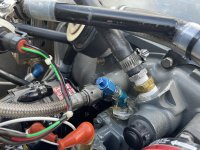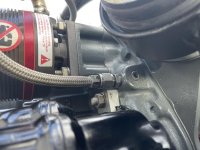We have plumbed in a remote gauge (bluetooth) and it mirrors the Dynon D180 readings on the panel.
.
That sounds a lot like a bad OP sensor. Did you just put another instrument on the same sensor or did you put in a tee with a new sensor? If the latter, there are not many mechanical things that will swing the OP from 40-105 in quick fashion, at least not in a plane that used to swing between 50 and 80, based upon RPM. You can get this when going from idle (low OP) to higher RPM (high OP) and the same going back to idle, but it is VERY consistent and predictable and the OP will religiously follow linear relationships with RPM. Pretty sure it is not the relief spring and I would put the old one back just the way you found it as you troubleshoot. You have obviously shown yourself that is not the cause and may now create a very low OP with no spring force.
You get high pressure when the pump is producing too much flow and there is nowhere for it to go and usually a blockage or relief problem. Low pressure is either the opposite (not enough volume from pump) or too many leak sources, such as issues with relief bleeding off too much or major bearing wear, or other leak source, etc. Almost never see both happening at the same time. The one exception that I experienced was when there was a mismatch in parts between the block and press relief housing, but that was consistent in it;s movements and happened from day one. OP went up with RPM to a certain point and then dropped 15 and stayed there. Nothing like your symptoms.
I would spend more time on instrumentation. Buy a mech OP guage and find a way to tee it into the system. This could also be some type of debris or issue with the hose going between the block and sensor. My best guess is that the actual OP is not going from 40-105 back and forth. If it is instrumentation, you now have no idea how low you have made the pressure with the new relief setup.
Yes, it is following throttle, but I assume that you do not normally get 105 in the pattern or anytime other than a cold start. This is the smoking gun. The ONLY way to get more pressure than you got yesterday without any changes is for there to be some type of
blockage or intermittent issue with the relief ball not coming off the seat enough. This can happen, however, for it to then fall to 40 at idle, which I assume is lower than it was yesterday, points to a completely different group of problems, such as the ball not fully seating or not having enough pressure or system
leaks. It is hard to imagine intermittently going between blockage at high RPM and leaks at low RPM. However, if it were happening it is most likely happening in the relief, but not the spring itself. More likely a metallic defect in the assy. Still hard for me to imagine how a relief sometimes restricts too much and then restricts too little. This leads me back to absolutely confirming your readings before attacking this.
If you have an inverted oil system with all the other check balls and diverters and goodies, that is a whole different kettle of fish and outside my area and wouild be high on my suspect list.






